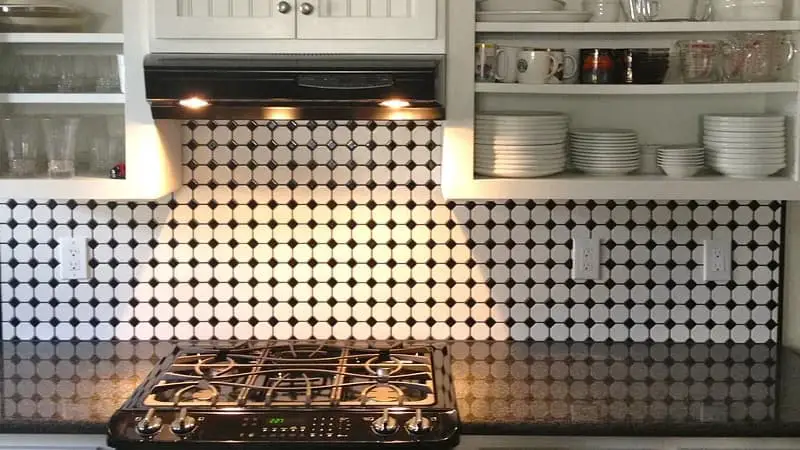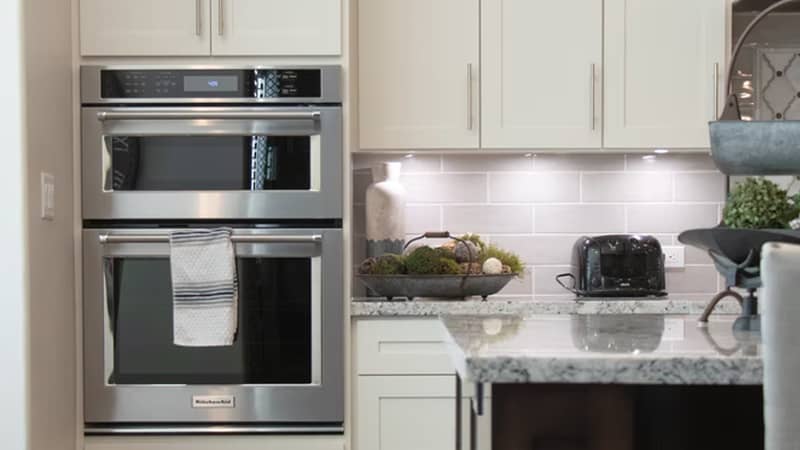A memorable kitchen is one with a lovely design and enough space for the family to spend time together. You may consider tucking appliances into cabinets to save space, but is it safe to build an oven into a wooden cabinet?
It is safe to build an oven into a wooden cabinet. As long as you understand and prepare for the type of oven, its heating capacity, and venting requirements, you shouldn’t have too many concerns about it being a fire hazard.
This article looks at placing an oven in a wooden cabinet and how safe installing an oven in a wooden cabinet is. It also describes how you build an oven cabinet.
Can an Oven Be Placed in a Wooden Cabinet?

Placing ovens in a wooden cabinet is not a new trend, as kitchens have carried this design for decades. When you place an oven in a wooden cabinet, you not only save space, but you give your kitchen a clean, uniform look.
You can either build the unit or install a standalone oven in the cabinet. The opening for a built-in oven is simply a box supported by a constructed pine frame, and most of these openings are a standard 60 cm or 90 cm space.
Cabinets surround the oven unit, you may build it above or under the cabinets, and the unit serves as a suitable storage space for all your cooking utensils. If your oven is already installed in a cabinet, you are in luck.
You can go straight to getting the maximum benefit from it. If not, installing one in a cabinet space is very easy. Besides the 60 cm or 90 cm standard ovens, there is also a 45 cm model size that recently hit the market to cater to people’s needs with a limited kitchen space.
Is It Safe to Build an Oven in a Wood Cabinet?
A built-in oven cooks food through electromagnetic radiation, and a regular home oven will have single or double electric coils at the bottom for producing heat. Electricity from your outlet powers the coils, and they produce radiant heat.
Although this heating component can cause fires if they overheat, most oven manufacturers build their ovens with a ventilation system that can dissipate smoke and hot air upwards, away from objects nearby and people in proximity.
It also helps if you install a kitchen vent; close venting, primary and secondary venting, to prevent Carbon Monoxide build-up. Concerning the high temperatures an oven can reach and the fire risk it poses in a wood cabinet, here are some points to note:
- The exterior sides of ovens don’t produce excessive heat—it only gets to about 200 degrees Fahrenheit (93 degrees Celsius), which is relatively low compared to the interior heat.
- If the materials of the counters, cabinets, and wall coverings around the oven can withstand the external temperature, then it is safe to build an oven in a wooden cabinet. You can also use the same materials used for the surrounding cabinets.
Even toaster ovens can go into a wooden cabinet with the right oven and precautions. While some radiate too much heat to be safely put in a wooden cabinet, some cool touch toaster ovens are available, and they remain relatively cool on the outside despite the heat inside.
When placing a toaster in a cabinet for regular use, you may need to put a heat shield on the wood above the toaster and behind the toaster.
A heat shield is a thin metal or Plexi strip that absorbs and releases heat faster than wood does, and it keeps that heat from building up in the cabinets to mitigate the fire hazard.
An under-cabinet heat guard/shield can also be used to mount a toaster oven in the kitchen cabinet, and it will protect the underside of the cabinet from the heat released off the top of the toaster oven.
How Do You Build an Oven Cabinet?

Building an oven cabinet is not a hard task. Remember that an oven cabinet or opening is simply a box supporting a pine frame. Before you build, here are some important things to keep in mind:
- Ensure all materials you use can withstand temperatures of up to 200˚F.
- You will eliminate the back panel of the cabinet because most ovens need the full depth of the cabinet.
- Make sure there is enough space to hold the oven before you start constructing.
- The cabinet should be able to hold a weight of about 350 pounds.
- Leave the unfinished sides of the word facing the oven because finishes, lacquers, paint, etc., may be unable to withstand heat like wood can.
- Check the temperature of any glue you use and make sure it is suitable for the expected temperatures.
- The oven base must be three inches wider than the oven.
Plywood and pine are often used to build oven cabinets, and all you have to do is get the correct sizes. To save some money, you can substitute Baltic birch for the hardwood plywood used for the cabinet’s back and sides (they won’t be visible). To construct the cabinet, follow these steps:
- Arrange the pieces of pine and staple the pieces to form a rectangular frame.
- Arrange the plywood on the frame, flush on three sides with one end extending 2 inches over the end of the frame. The part that extends is the toe-kick lip on all base cabinets (the front of the oven).
- Next, secure the plywood to the pine base frame by shooting staples around the perimeter.
- Place the oven on the base and slide the cabinet and oven back into the existing cabinets underneath the countertop.
- Cut and glue the front edges.
- Finish with a stain and lacquer as needed. Apply them to the hardwood fillers to match the surrounding cabinets for a complete built-in look.
- You can add a trim if you desire, and it is usually added at the bottom or top of the oven between the countertop if there is space.
Always wear safety goggles and other protective equipment when building the cabinet. You don’t have to break the bank to achieve a clean look for your kitchen, and a built-in oven can give you that look.

